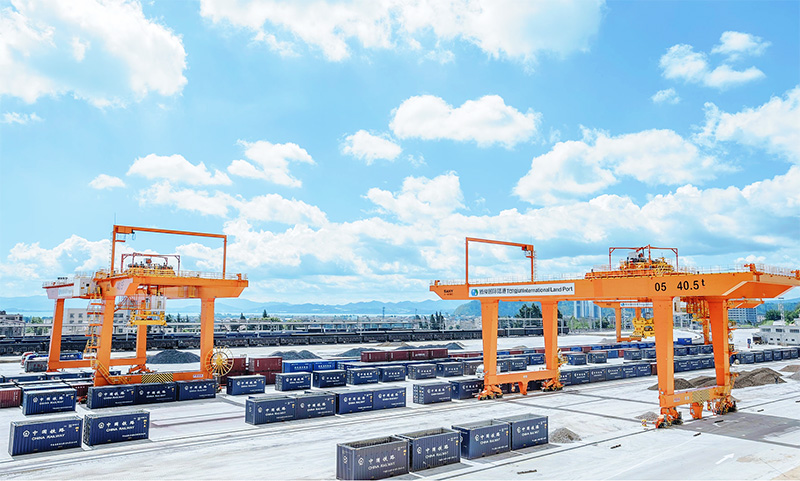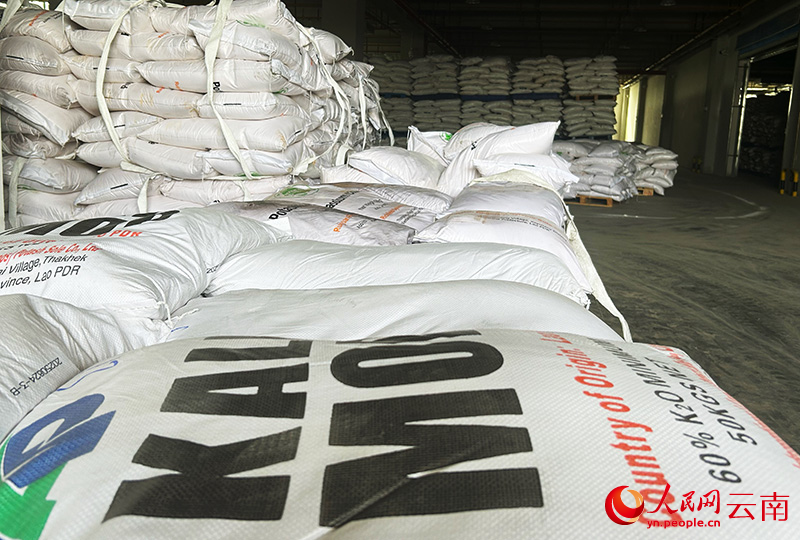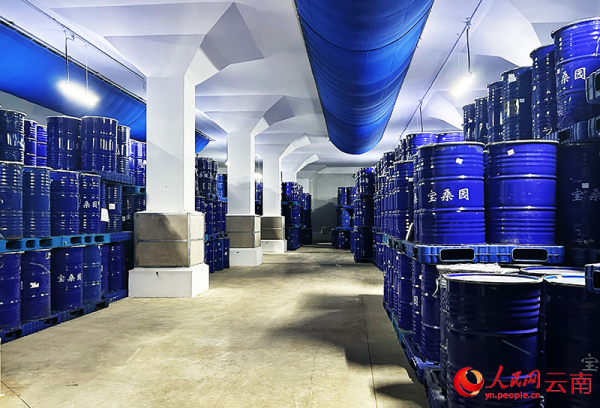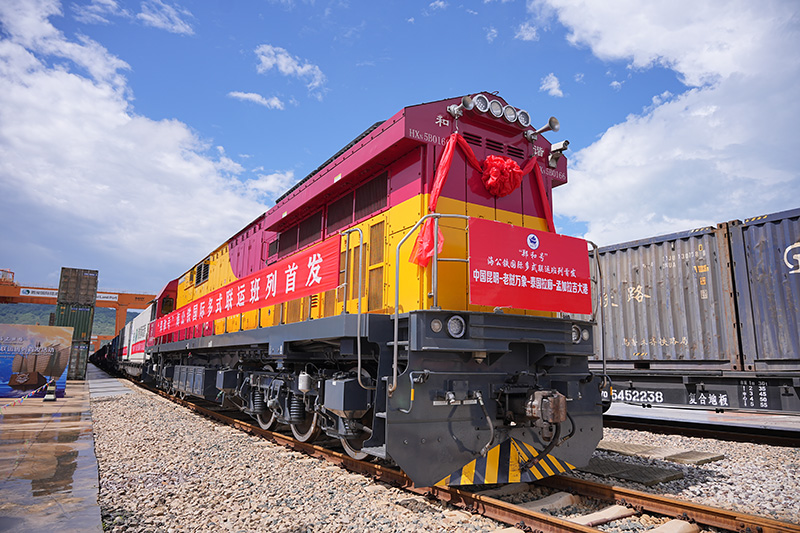Packing, loading, dispatching, customs declaration… With a long whistle, the “Zheng He” train, fully loaded with goods such as fertilizers and characteristic fruits and vegetables from the Yunnan Plateau, slowly started from Jinning District, Kunming City, Yunnan Province, and sped along the China-Laos Railway towards Vientiane, Laos. A few weeks later, these specialty goods will be delivered directly to markets along the Indian Ocean and Pacific coasts via three routes using a sea-road-rail multimodal logistics transport method.
The starting point of this train is the Tengjun International Land Port, which was recently awarded the “5A-Level Land Port” designation, the first land port in Yunnan to receive this honor.
Over six hundred years ago, Zheng He, who hailed from Jinning, Kunming, led his fleet on voyages, sailing the oceans seven times. Over six hundred years later, an international freight train named after “Zheng He” is writing a new legend of the “Maritime Silk Road” along the Southern International Land-Sea Trade Corridor.

Tengjun International Land Port Road-Rail Logistics Center. Photo provided by Tengjun International Land Port.
Hub as Foundation: Building Platforms, Linking Globally
Walking into the Road-Rail Intermodal Center of Tengjun International Land Port, containers stand like forests. Huge gantry cranes precisely grab containers with standard and steady movements, and reach stackers shuttle flexibly between yards for loading and unloading; the work area is bustling. Looking along the dedicated railway line beside the containers, the end point is the Zhongyicun Station on the China-Laos Railway. This railway acts like a link, closely connecting Tengjun International Land Port with countries in South and Southeast Asia.
Inside the warehouse of the bonded logistics center a hundred meters away, potash raw materials from Southeast Asia are piled high, with many workers operating forklifts in an orderly manner. “In the past, transporting these raw materials via traditional methods took 7 to 10 days. Now, via the China-Laos Railway, it takes about 3 days, saving more than half the time compared to before,” said Yang Rongjie, Deputy General Manager of Yunnan Tengjun Bonded Logistics Management Co., Ltd., pointing to the goods in the warehouse. “Our bonded logistics center enjoys preferential policies including ‘deferred tax payment for imported goods, early tax rebates for exported goods, and tax-free transfers within the center’. Bulk entry and retail exit, along with deferred tax payment, can greatly reduce corporate storage and capital turnover pressures, lowering logistics costs for customers by 10%–30%.” Currently, the Laotian potash imported through Tengjun International Land Port accounts for over 98% of the total potash imports via the China-Laos Railway in Yunnan Province, providing crucial support for the stable supply in the regional potash market and ensuring agricultural production security.

The warehouse at Tengjun International Land Port’s Bonded Logistics Center holds large quantities of potash raw materials from Southeast Asian countries. Photo by Liu Yi, People’s Daily Online reporter.
As the “Western Wing” of the “Two Cores, Two Wings” structure of the Kunming International Land Port, Tengjun International Land Port is one of the most important logistics hubs along the China-Laos Railway, boasting unique geographical advantages and being surrounded by numerous fertilizer, vegetable, and fruit production and trading enterprises. Building on this foundation, Tengjun International Land Port has created five core functional areas integrating smart operations, bonded logistics, multimodal transport, intelligent warehousing, and international procurement, accelerating the construction of an international supply chain operation and organization center and a comprehensive logistics service platform, laying a solid foundation for the high-quality development of the regional modern logistics industry.
Since 2024, Tengjun International Land Port pioneered the national “China-Laos Railway + Bonded” model, actively building an international fertilizer trading and distribution center, developing Laotian potash into a “star product”, and establishing an efficient two-way import-export corridor for fertilizers, ensuring the smooth flow of this crucial agricultural production material between domestic and international markets.
Based in Yunnan and facing South and Southeast Asia, Tengjun International Land Port has been building platforms and continuously deepening international land port connectivity and cooperation. Since 2012, it has cumulatively signed 18 strategic cooperation agreements with key hubs and logistics enterprises in South and Southeast Asian countries, such as the Thanaleng Land Port in Laos, Ranong Port in Thailand, and Lankabang International Land Port, promoting the construction of the Southern International Land Port Alliance, and building an efficient, safe, and convenient international logistics and supply chain network covering South and Southeast Asia, becoming a significant force in regional logistics cooperation.
Hardware as the “Bones”: Strengthening Foundations, Enhancing Efficiency
In logistics, efficiency is paramount. And behind efficiency lies solid hardware support.
In recent years, Tengjun International Land Port has continuously strengthened the “steel frame” of its logistics system through systematic upgrades of its transport equipment.
Upgrading transport equipment was the first step in this upgrade.

Large quantities of mulberry juice are stored in the cold storage at Tengjun International Land Port. Photo by Liu Yi, People’s Daily Online reporter.
“We have introduced nearly a hundred high-performance intelligent refrigerated containers,” said Zhou Han, Administrative Director of Yunnan Tengjin Logistics Co., Ltd., pointing to the neatly arranged cold chain equipment in the yard. “These intelligent refrigerated containers, through their precise temperature control systems, can strictly limit temperature fluctuations within 1°C throughout the entire journey, providing a ‘constant temperature and humidity’ transport environment for delicate tropical fruits like durian and mangosteen. Simultaneously, by collecting real-time data on equipment status, temperature, humidity, and location, they form a transparent ‘dynamic data chain’, allowing customers full visibility over the entire transport process.”
Today, thanks to this intelligent cold chain system, tropical fruits from Southeast Asia and characteristic plateau fruits and vegetables from Yunnan achieve a safe and efficient “two-way journey”, significantly improving logistics timeliness and markedly reducing comprehensive costs.
The hardware upgrade is also evident in the subtle details.
Inside the yard, a batch of specially made plastic pallets caught the reporter’s attention. “By adjusting the material composition and adding anti-slip surface granules, we have significantly enhanced the durability of the pallets,” Zhou Han further explained. “Their impact resistance and wear resistance far exceed those of wooden pallets, with a service life of 5 to 10 years, more than five times that of ordinary wooden pallets.”
These customized pallets can adapt to extreme temperature differences from -30°C to 45°C, ensuring the safety and stability of goods from cold storage to outdoor loading and unloading, solidifying the foundation for the “last mile” of Tengjun International Land Port’s “cold chain + multimodal transport” advantage.
Full forklift operation, shared “pallet pool”… Here, goods achieve seamless connection from the factory workshop to the station containers “on a single pallet”. This model not only promotes standardized connections across the industry chain but also optimizes logistics resource allocation.
“The overall upgrade of the hardware system has allowed us to take solid steps on the path towards standardization and specialization,” Zhou Han stated. “This is a crucial part of building a modern international land port.” Through this series of robust upgrades, Tengjun International Land Port is supporting a more efficient and reliable logistics and supply chain service system with its increasingly strong “bones”.
Software Empowerment: Smart Operations, Strengthening the “Brain”
Compressing time enhances and brings spatial distances closer, while innovative operational models make logistics transport more intelligent and efficient.
On July 4 this year, the “Zheng He” train, fully loaded with local Yunnan vegetables, fertilizers, and feed, departed from Jinning, Kunming, along the China-Laos Railway towards Vientiane, Laos.
“After arriving in Vientiane, the goods continued their journey along three routes,” detailed Zhang Yaqi, Operations Manager of Yunnan Tengjun International Logistics Co., Ltd. “One route transfers to the Thai railway to Saraburi Province; another route connects by road to Laem Chabang Port, then by sea to Singapore; the third route goes to Ranong Port in Thailand, by sea to Yangon, Myanmar, and finally to Chittagong, Bangladesh.”
Through this international multimodal transport network combining rail, road, and sea transport, Yunnan’s plateau specialty products are accelerating their journey “to the sea” and to the world.

On July 4 this year, the “Zheng He Hao” train made its inaugural trip from the Tengjun International Land Port. Photo provided by Tengjun International Land Port.
“The ‘Zheng He Hao’ also adopts a ‘one-stop, one-bill system’ service, integrating the entire process including port operations, transshipment, customs declaration, and customs clearance, achieving ‘one-time entrustment, full-process responsibility’,” said Zhang Yaqi. “The multimodal transport integrated service platform we built has achieved seamless connection with the ERP systems of enterprises settled on the platform. Customs declaration business data achieves efficient interaction, and logistics information transmission is more timely and accurate.”
In fact, not only the “Zheng He Hao”, such exploration had already begun earlier.
On December 4, 2021, Tengjun International Land Port successfully launched the first cold chain transport special train on the China-Laos Railway; Since September 2024, it has regularly operated the “Yunnan Hao” China-Laos-Thailand multimodal transport “one-bill system” international freight train, achieving the transport of Yunnan vegetables from Kunming to Vientiane, Laos via the China-Laos Railway within 72 hours, and then transshipped by road to Bangkok, Thailand. Compared to traditional transport methods, costs are reduced by 30% and efficiency is increased by 40%.
Today, relying on its comprehensive integrated hub functions and the international multimodal transport service capabilities formed by brand trains like the “Zheng He Hao” and “Yunnan Hao”, Tengjun International Land Port is fully committed to building a distribution center for South and Southeast Asia through “platform-based operation”, accelerating industrial agglomeration and commercial circulation.
From January to September this year, the railway transport transit volume at Tengjun International Land Port reached 2.0323 million tons, a year-on-year increase of 25%. Among this, cross-border transport on the China-Laos Railway completed 7163.75 TEUs, a year-on-year increase of 107%, achieving remarkable results.
Currently, Tengjun International Land Port is actively building the Kunming International Fertilizer Trading Distribution Center and the International Fruit and Vegetable Trading Distribution Center, accelerating the agglomeration of characteristic industries such as fertilizers, fruits, and vegetables within the region, and promoting the integrated development of “hub economy” and “platform economy”.
The southward opening is surging with vigor. As a “5A-level Land Port”, Tengjun International Land Port establishes its foundation with the hub, strengthens its framework with hardware, and forges its spirit with software, injecting strong momentum into regional economic development and opening up.




